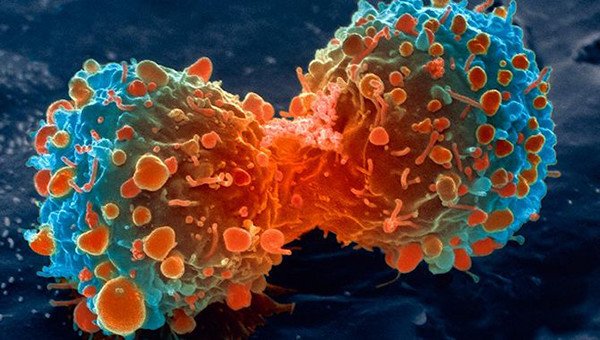Why is it so hard to cure cancer?
Why is it so difficult to cure cancer? We've harnessed electricity, sequenced the human genome, and eradicated small pox. But after billions of dollars in research, we haven't found a solution for a disease that affects more than 14 million people and their families at any given time.
Cancer arises as normal cells accumulate mutations. Most of the time, cells can detect mutations or DNA damage and either fix them or self destruct. However, some mutations allow cancerous cells to grow unchecked and invade nearby tissues, or even metastasize to distant organs. Cancers become almost incurable once they metastasize. And cancer is incredibly complex. It's not just one disease. There are more than 100 different types and we don't have a magic bullet that can cure all of them. For most cancers, treatments usually include a combination of surgery to remove tumors and radiation and chemotherapy to kill any cancerous cells left behind. Hormone therapies, immunotherapy, and targeted treatments tailored for a specific type of cancer are sometimes used, too. In many cases, these treatments are effective and the patient becomes cancer-free.

But they're very far from 100% effective So what would we have to do to find cures for all the different forms of cancer? We're beginning to understand a few of the problems scientists would have to solve. First of all, we need new, better ways of studying cancer. Most cancer treatments are developed using cell lines grown in labs from cultures of human tumors. These cultured cells have given us critical insights about cancer genetics and biology, but they lack much of the complexity of a tumor in an actual living organism. It's frequently the case that new drugs, which work on these lab-grown cells, will fail in clinical trials with real patients. One of the complexities of aggressive tumors is that they can have multiple populations of slightly different cancerous cells. Over time, distinct genetic mutations accumulate in cells in different parts of the tumor, giving rise to unique subclones. For example, aggressive brain tumors called glioblastomas can have as many as six different subclones in a single patient. This is called clonal heterogeneity, and it makes treatment difficult because a drug that works on one subclone may have no effect on another.
Here's another challenge. A tumor is a dynamic interconnected ecosystem where cancer cells constantly communicate with each other and with healthy cells nearby. They can induce normal cells to form blood vessels that feed the tumor and remove waste products. They can also interact with the immune system to actually suppress its function, keeping it from recognizing or destroying the cancer. If we could learn how to shut down these lines of communication, we'd have a better shot at vanquishing a tumor permanently. Additionally, mounting evidence suggests we'll need to figure out how to eradicate cancer stem cells. These are rare but seem to have special properties that make them resistant to chemotherapy and radiation. In theory, even if the rest of the tumor shrinks beyond detection during treatment, a single residual cancer stem cell could seed the growth of a new tumor. Figuring out how to target these stubborn cells might help prevent cancers from coming back. Even if we solved those problems, we might face new ones. Cancer cells are masters of adaptation, adjusting their molecular and cellular characteristics to survive under stress. When they're bombarded by radiation or chemotherapy, some cancer cells can effectively switch on protective shields against whatever's attacking them by changing their gene expression. Malignant cancers are complex systems that constantly evolve and adapt. To defeat them, we need to find experimental systems that match their complexity, and monitoring and treatment options that can adjust as the cancer changes.
But the good news is we're making progress. Even with all we don't know, the average mortality rate for most kinds of cancer has dropped significantly since the 1970s and is still falling. We're learning more every day, and each new piece of information gives us one more tool to add to our arsenal.
@originalworks
The @OriginalWorks bot has upvoted and checked this post!
Some similarity seems to be present here:
https://karlmorseofficial.tumblr.com/post/165881388101/colds-damn-do-u-ever-see-a-guy-and-know-he
This is an early BETA version. If you cited this source, then ignore this message! Reply if you feel this is an error.
One of the take-home messages from this documentary is that cancer is not a single disease. It is a cluster of 200 diseases, since there are about 200 cell types in the human body. http://www.pbs.org/show/story-cancer-emperor-all-maladies/
There's also the microbiome effects, which people only thought to look for recently. https://www.theatlantic.com/science/archive/2017/09/how-bacteria-could-protect-tumors-from-anticancer-drugs/539670/
It's not only the different cell groups that can evolve into different types of cancer. Each cell is capable of mutating into cancer due to different sets of changes in their genome. Theoretically there's an infinite number of cancers, though most of the time we only see the more common variants.
For example basal cell carcinoma and squamous cell carcinomas (two of the most common skin tumours) both arise from a single cells type, during different stages of it's development. The same can be said for all the types of lymphoma and a number of the luekemias which have a large amount of practical overlap.
Great article, keep up the good work!
There are several cures for cancer but these do not include slash, burn and poison . Avoid conventional barbarism and you should be OK
I'm sorry but the article above outlines exactly why it's so hard to cure cancer, but you'd prefer to stick with your uneducated pseudo-scientific views?